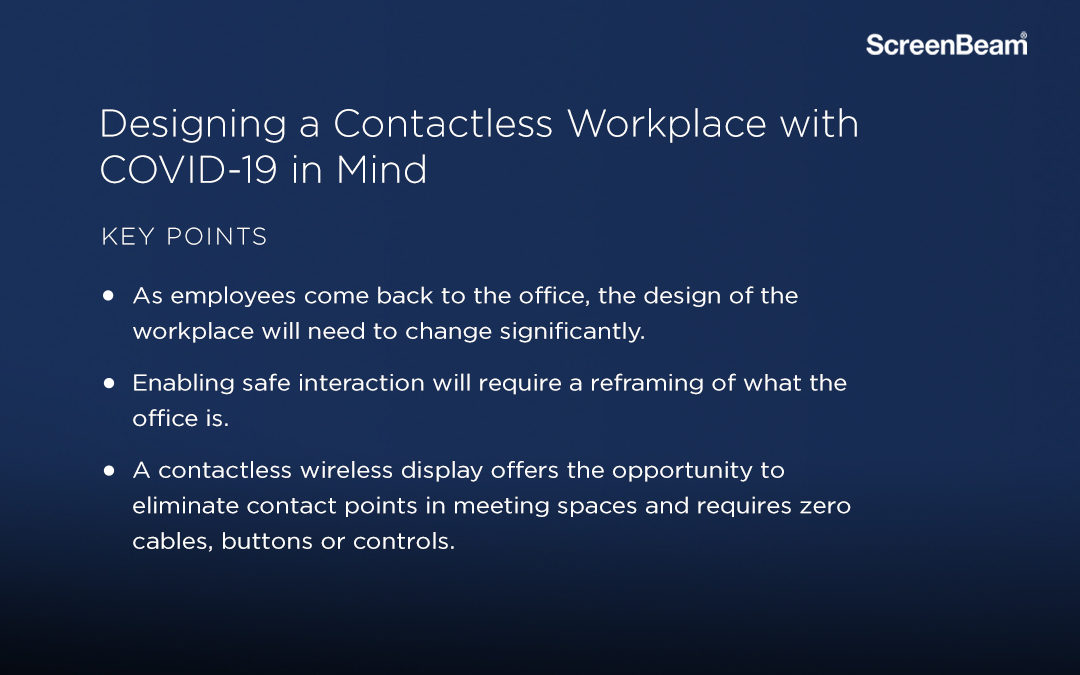How the world works will forever be different in a post-COVID-19 world. As employees come back to the office, the design of the workplace will need to change significantly.
The modern, open layout workplaces that have become common will need careful reconsideration. One aspect of this shift is to develop contactless workplaces that enable collaboration and socialization with safety in mind.
Workers Miss Interaction
Data from the 2020 Gensler Work from Home Survey revealed that the primary reason workers want to return to the office is interaction with colleagues. Enabling this interaction safely will require a reframing of what the office is.
What is the new role of the office? Is it much different than it was a year ago? The reality is that, before the pandemic, many workers had the option to work from home. Gensler’s 2020 U.S. Workplace Survey found that 50% of workers spent at least one day working outside the office. Employees want flexibility, but they also want to work together and feel like part of a community.
So, the role of the office in the future is about engagement and human connection. To make this a reality, more than just a reconfiguration of spaces is necessary.
It will also require sophisticated technology that makes employee collaboration easy and satisfies social distancing protocols. The “new” office will also likely seat fewer people, according to Gensler experts who foresee capacity to be 15 to 30% less.
Unassigned Seating Likely to Trend Down
The Gensler 2020 Workplace Survey spends a lot of time on the subject of unassigned seating in the office. According to the survey, one in 10 workers were in an unassigned model, with many unhappy with it. The survey also found it hampers focused work and virtual collaboration. With the need to reduce multiple people touching surfaces and other safety concerns, workplace design decision-makers are likely to scratch these ideas.
Unassigned seating does have pros. It gives people the flexibility to work where they feel comfortable and interact more. Those freedoms don’t have to disappear. They simply need to be applied in different ways, and contactless workplaces are one avenue to do so.
Cutting Cords and Going Touchless
Even before the pandemic hit, organizations were seeking ways to leverage technology for better collaboration. Conference rooms have been meeting hubs for some time, with all the bells and whistles of the digital world. The problem? Well, there were two main ones.
First, these setups were hard to navigate by many, requiring IT assistance more times than not. Second, the technology wasn’t wireless and came with an assortment of cables, buttons, dongles, switches, remote controls and switches.
So many things to touch and turn on—not the kind of system you want when there’s a virus pandemic occurring. A contactless wireless display can resolve both challenges.
Implementing a Contactless Wireless Display for a Safer, Still Collaborative Workplace
Interaction and connection are still possible; you just don’t have to be side by side around a conference table. A contactless wireless display offers the opportunity to eliminate contact points in meeting spaces. It’s an app-free approach to presenting and requires zero cables, buttons or controls.
Companies can use it in meeting spaces or large common areas. They can share their screens and work on documents in real-time. It enables a scenario of collaboration while also being mindful of contagion risk. Creating a contactless meeting space is easy and affordable. It also works within one platform, so you don’t have to build a complete technology stack.
Contactless Workplaces Don’t Remove Connections
One thing is clear; employees still value the workplace and what it brings to their life. It’s as much about being productive and effective as it is about fostering community.
As workplace designers think about how to change flows and rebuild the spaces of the future, they should certainly consider contactless workplace technology and the benefits it can bring.
To learn more about ScreenBeam’s role in the contactless workplaces of the future, visit screenbeam.com.
